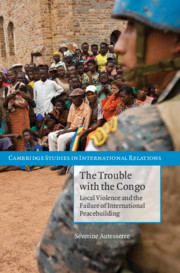Book contents
- Frontmatter
- Contents
- List of Figures and Tables
- Glossary of Acronyms, Names, and Ethnic Terms
- 1 Map of the Democratic Republic of the Congo and Its Neighbors
- Preface and Acknowledgments
- 1 The Peacebuilding World
- 2 A Top-Down Problem
- 3 A Top-Down Solution
- 4 A Bottom-Up Story
- 5 The Defeat of Bottom-Up Solutions
- 6 Beyond the Congo
- Appendix: Chronology
- Bibliography
- Index
- Cambridge Studies in International Relations
1 - The Peacebuilding World
Published online by Cambridge University Press: 05 June 2012
- Frontmatter
- Contents
- List of Figures and Tables
- Glossary of Acronyms, Names, and Ethnic Terms
- 1 Map of the Democratic Republic of the Congo and Its Neighbors
- Preface and Acknowledgments
- 1 The Peacebuilding World
- 2 A Top-Down Problem
- 3 A Top-Down Solution
- 4 A Bottom-Up Story
- 5 The Defeat of Bottom-Up Solutions
- 6 Beyond the Congo
- Appendix: Chronology
- Bibliography
- Index
- Cambridge Studies in International Relations
Summary
In mid-2007, in a beautiful garden overlooking Lake Kivu, I listened to an old man named Georges recall the turmoil of the mid-1990s in the eastern part of the Democratic Republic of the Congo. Before that time, he and his small circle of friends, all people of European descent but born and raised in the Congo, had been the only white people around, with the exception of the occasional development worker. This situation suddenly changed in the mid-1990s, when the Rwandan genocide sent 2 million refugees pouring into the eastern Congo. Two large-scale wars started in the massacre's wake, the first in 1996 and the second in 1998. Contingents of nongovernmental organization staff members and United Nations (UN) officials arrived, and eventually diplomats followed. The old white Congolese found them all quite amusing. “We called them ‘the humanoids,’” Georges said. “It fits them very well, because they are people full of ideals, of vigor … but they come from another planet. They are completely disoriented.” I could not help but think that, in a few sentences, Georges had just encapsulated my six years of research on the international intervention in the Congo. International peacebuilders have their own world, with its own rituals, its own customs, its own beliefs, its own roles, its own stars, its own villains, its own rules, its own taboos, its own meeting places – in brief, its own culture. This peacebuilding culture shaped the intervention strategy in the Congo.
- Type
- Chapter
- Information
- The Trouble with the CongoLocal Violence and the Failure of International Peacebuilding, pp. 1 - 40Publisher: Cambridge University PressPrint publication year: 2010

